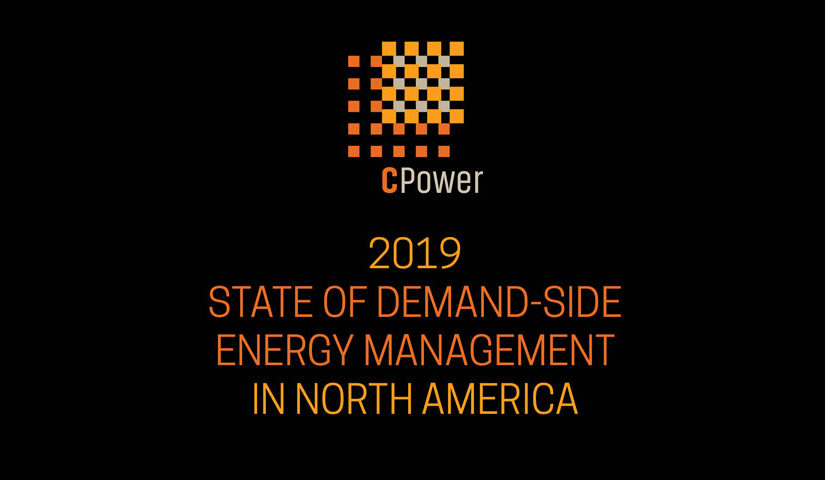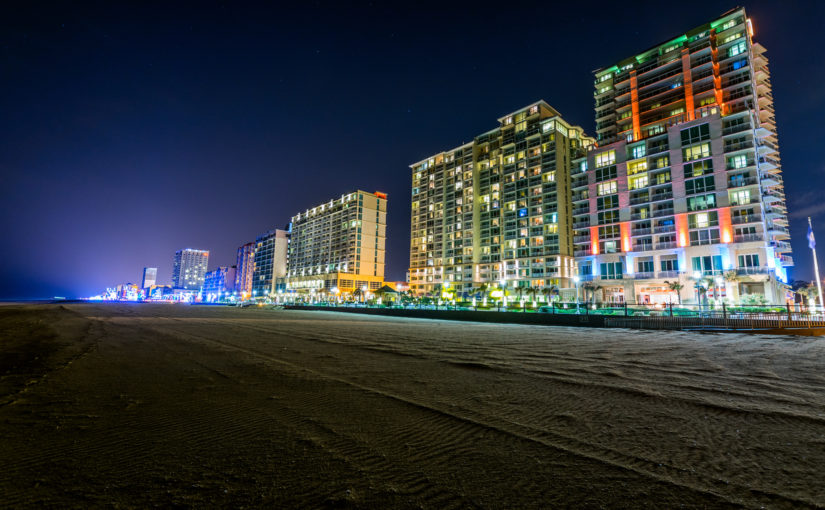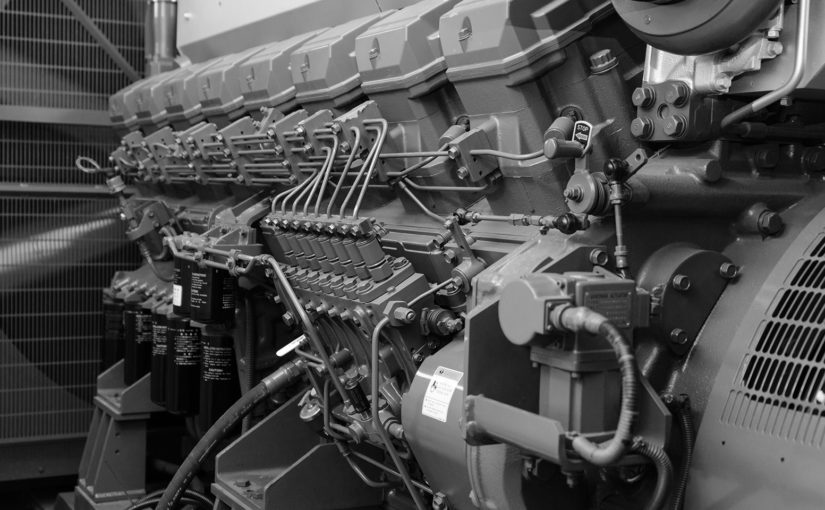PJM: A Look Ahead to Summer ’19 and Beyond
Summer 2019 is right around the corner, which means another season of PJM’s Emergency Capacity demand response (DR) program is set to kick off. This 2019/2020 marks an important pivot point for DR in PJM. With DR enrollment underway, let’s take a look at some things to expect this summer.
2019 Summer Outlook
Weather-wise, early indications point to the PJM region experiencing normal to mild summer temperatures. That’s good news for DR customers in Emergency Capacity but may be challenging for peak shavers to accurately predict PJM’s 5 CP (Coincident Peak) hours. The weak El Nino climate is not expected to have much of an impact, although there’s a good chance that the historically wet 2018 season will carry over to 2019. So don’t put away those rain slickers just yet!
Capacity-wise, PJM forecasts summer peak load of 151,358 MWs. Unlike in Texas, where the grid operator ERCOT (Electric Reliability Council of Texas) is forecasting a reserves situation that make summer emergency events likely, the PJM region at this point seems to have adequate reserves. As we learned during the 2014 Polar Vortex, though, nothing is completely certain when it comes to expected supply and demand. Here’s hoping the summer weather forecast proves to be right.
Goodbye Base and Summer Capacity, Hello Capacity Performance— and Seasonal Aggregations
June 2019 will mark the final season of PJM’s summer-only DR programs. PJM retired the Limited and Summer Extended DR programs after the 2017/18 delivery year, and now will retire the Base Capacity program at the conclusion of the 2019/20 delivery year.
This will usher in the long-talked-about Capacity Performance (CP) DR program as the lone DR program available, starting next year for the 2020/21 delivery year. As you probably know (and as we discussed in last year’s white paper on the myths around CP), the CP program required DR participation and compliance year-round, not just during the summer. As originally designed, CP DR customers would have to participate with one load reduction value for the entire year. To many, this has caused far more problems than it solved, as many DR customers feared having their participation levels drastically reduced — or even dropped from the program entirely — due to concerns over their inability to participate and comply in the winter.
Fortunately, PJM and the FERC (with a little help from CPower Market Development and others, advocating on our customers’ behalf) may have found a way to put those concerns to rest.
The FERC (Federal Energy Regulatory Commission) recently approved a PJM filing that will now allow DR customers to participate in CP with two different summer and winter seasonal load reduction values. Of course, there’s a catch. Participating with separate summer and winter values is contingent upon the customer’s curtailment service provider (CSP, i.e., CPower) being able to offset its seasonal load to create “CP Aggregations.”
How does that work? Let’s take two customers, Alpha Amalgamated Alloys and Beta Better Ball Bearings. Each has participated in summer-only DR for years. Now, however, they have to make year-round commitments, and they’re stuck.
Enter the new rule and their CSP, CPower. CPower works with each to determine what each can contribute for summer and, separately, for winter. Alpha determines that they can reduce 5 MW in the summer but only 2 MWs in the winter. Beta determines that they can reduce 1 MW in the summer but 4 MWs in the winter. And they’re both in the same utility zone within PJM.
Under the rule as originally created, Alpha would be faced with having to curtail only 2 MWs in the summer, when they used to be able to curtail—and monetize—5 MWs. Meanwhile, Beta would be unable to monetize their additional 3 MWs of now-required load in the winter. That could change the desire to participate in Emergency Capacity DR for these two long-time customers.
The new rule, however, allows their CSP to aggregate (or combine) their reductions to create a CP zonal aggregation of 6 MWs year-round. Their combined summer reductions and winter reductions balance each other out and comply with the new CP requirements. Each continues to benefit from DR participation in PJM.
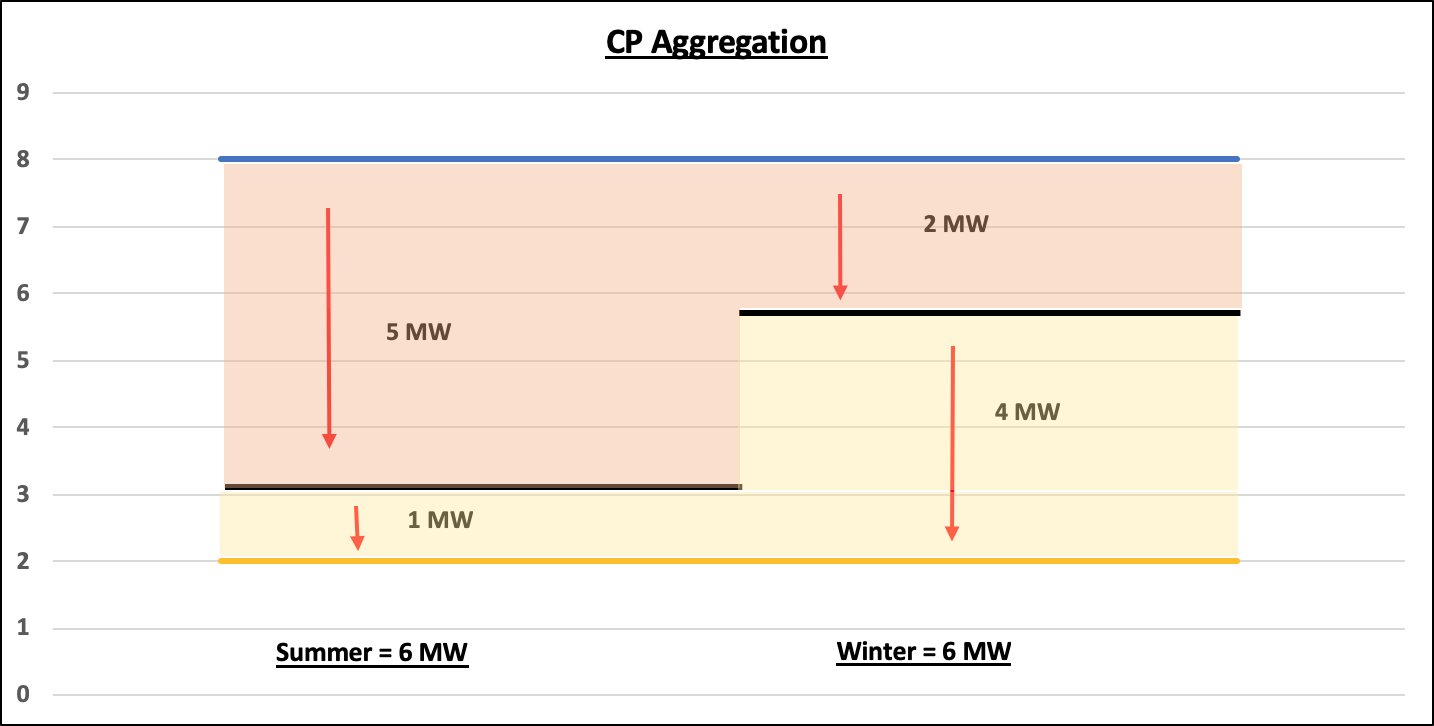
This program rule change, thankfully, allows more flexibility and opportunity for PJM’s DR customers to participate as Emergency Capacity resources (which PJM always needs). This assumes, however, that their CSP has the market position and a diverse portfolio to successfully manage these DR CP programs.
Shameless plug: CPower, of course, has the capability to generate zonal CP aggregations across all PJM zones and all customer types. We’ve worked hard to not only build ourselves into the top curtailment aggregator in PJM; we’ve also advocated tirelessly before PJM to create this opportunity for our customers to ensure that CP doesn’t negatively impact PJM’s vital electric reserves. In this way, barriers become opportunities, and everyone wins.
What to Look Out For
PJM has pushed back their next Base Residual Auction (BRA) for the 2022/23 delivery year from May, 2019, to August, 2019 and the possibility still remains that it could get pushed back again until early Spring 2020. This will allow for some RPM rule changes to be implemented. If you’re interested in future capacity prices and DR availability, stay tuned, as the results for that auction won’t be known for a few more months.
PJM stakeholders are discussing potential changes to the mandatory DR test even that occurs each summer if there is no actual emergency event called. Some topics of discussion are: increasing the test event to longer than one hour; compensating test event compliance with emergency energy payments; PJM scheduling the test event instead of the CSPs; and possibly a mandatory winter testing provision. Nothing’s set in concrete yet, and CPower will keep you up-to-date as the discussions move forward.
Just Released: 2019 State of the Market
Finally, CPower has released, “2019 State of Demand-Side Energy Management in North America.” This is an invaluable resource filled with analysis and commentary from CPower’s market experts (including yours truly). It covers all regions served and supported by CPower in the U.S. and Canada and will be an important source of information for DR customers and partners regionally and nationally. Download your guide here.
If you have any questions about goings-on in PJM now and in the future. don’t hesitate to reach out to the PJM team. As always, we’re here to help.
What has PJM learned from the Polar Vortex?
On January 2, 2014, a sudden stratospheric warming caused a breakdown of the polar vortex, a semi-permanent low-pressure system of cold polar air that helps the jet stream maintain a roughly circular path as it travels around the globe.
A healthy polar vortex keeps the jet stream in line, which in turn keeps the cold air up north and the warm air down south.
An unhealthy polar vortex allows the jet stream to break apart, allowing the Arctic’s frigid air to escape southward as it did in 2014. The 2014 Polar Vortex (officially the 2014 North American Cold Wave) led to record low temperatures in the US and caused PJM’s grid to face dire reliability concerns.
In the wake of the 2014 Polar Vortex, PJM established a new market design to better procure resources when the grid is stressed due to extreme weather.
Five years later, the PJM grid would again be challenged when a weak polar vortex led to temperatures in the US plummeting to record lows, including -23 degrees in Chicago in late January 2019.
That the PJM grid maintained its reliability in the winter of 2018/19 is a sign that recent market changes are working as designed.
Let’s examine those changes with an eye on how commercial and industrial organizations in the region can leverage their existing energy assets and achieve demand-side energy management success.
What did Winter 2014 Teach PJM?
On January 14, the coldest day of winter in 2014, 22% of PJM’s generation was unavailable to meet consumer demand. PJM knew they had to take action to ensure the grid had enough capacity in the future to meet the most daunting and coldest circumstances.
“To ensure reliability, we’re doing everything humanly possible. If the lights aren’t on, nothing else matters.”
–Terry Boston, PJM President and CEO
2014 PJM Annual Report
To guard against future outages like the ones experienced in 2014, PJM proposed to the Federal Energy Regulatory Commission (FERC) a redesign of the region’s Reliability Pricing Model (RPM), the capacity market that ensures long-term grid reliability by securing the appropriate amount of power supply resources needed to meet predicted energy demand three years in the future.
PJM’s Transition to Year-Round Demand Response (DR)
One of the more significant changes PJM implemented involves a transition to demand response programs that require year-round participation.
PJM’s two emergency capacity demand response programs available in 2019, Base Capacity and Capacity Performance, each reward year-round participation from its participants.
Base Capacity, however, differs from Capacity Performance in that it requires performance in the summer months of June through September, but can also reward for responding to dispatch throughout the year. 2019 will be the final year PJM offers Base Capacity.
These new programs replaced the legacy DR programs PJM previously offered until the end of the 2017/2018 program–Limited DR, Summer Extended DR, and Annual DR.
How has Capacity Performance affected grid reliability?
The short answer is PJM’s grid is doing just fine having shifted to Capacity Performance.
In an analysis on its system performance during the “bomb cyclone” cold snap from Dec. 28, 2017, through January 7, 2018 (the region’s coldest stretch since 2014), PJM confirmed its grid performed well, with excess resources available on days when temperatures were the most frigid.
But that doesn’t mean PJM doesn’t see room for improvement in 2019.
This post was excerpted from the 2019 State of Demand-Side Energy Management in North America, a market-by-market analysis of the issues and trends the experts at CPower feel organizations like yours need to know to make better decisions about your energy use and spend.
CPower has taken the pain out of painstaking detail, leaving a comprehensive but easy-to-understand bed of insights and ideas to help you make sense of demand-side energy’s quickly-evolving landscape.
Is Peak Shaving more Lucrative than Demand Response in PJM?
Peak-shaving, essentially the practice of an organization reducing its demand during times of peak grid stress to lower its capacity charges, is part of what the Federal Energy Regulatory Commission is considering as the agency examines PJM’s annual capacity construct.
In a June 2018 proposal, PJM stated it hoped to reduce its capacity market demand curve by including peak shaving among the variables it considers when developing its load forecast.
To do this, PJM would have to adjust its current forecasting model, which involves identifying gross load for a delivery year and establishing a forecast that includes economic, weather, and end-user changes, but excludes peak shaving as a variable.
PJM believes their proposed model will provide a more holistic view of the grid and its potential need for resources to maintain the balance between supply and demand.
Opponents are concerned whether PJM’s proposed methods for integrating peak shaving as a variable in forecasting its load are underdeveloped and will ultimately provide an accurate forecast.
They may have a point.
PJM’s proposal states among its outstanding issues that accounting for existing peak shaving activity relies on entities providing PJM with historical peak shaving activity and that currently there is no established best practice for obtaining this crucial data.
Is Peak Shaving Right for Your Organization?
Given all this uncertainty around peak-shaving in PJM, it’s a fair question to ask if the practice is right for your organization.
Since no two organizations are alike, the answer to that question will naturally vary from one organization to the next.
Consider that an organization involved in peak shaving will likely curtail for about 30 hours in a single summer in an attempt to time their curtailment with the hours PJM’s grid is at peak system load.
Is the organization better off curtailing for that long and realizing the savings in subsequent peak charges? Or would the organization be better off participating in demand response, which, if not called for an emergency event, only involves just one test hour during the summer?
It’s best for a given organization to consult a licensed curtailment service provider that has the ability to evaluate all of an organization’s energy assets and explain how they may best be leveraged in PJM’s existing markets to optimize savings and earnings through demand-side energy management.
This post was excerpted from the 2019 State of Demand-Side Energy Management in North America, a market-by-market analysis of the issues and trends the experts at CPower feel organizations like yours need to know to make better decisions about your energy use and spend.
CPower has taken the pain out of painstaking detail, leaving a comprehensive but easy-to-understand bed of insights and ideas to help you make sense of demand-side energy’s quickly-evolving landscape.
2019 State of Demand-Side Energy Management in North America
The 2019 State of Demand-Side Energy Management in North America is a market-by-market analysis of the issues and trends the experts at CPower feel organizations like yours need to know to make better decisions about your energy use and spend.
Energy Efficiency in ComEd
Case Study: City of Virginia Beach
Virginia Beach, Virginia – Energy Manager’s determined pursuit of energy efficiency savings earned the city tens of thousands of dollars in rebates in just a few short years. (Download this case study as a PDF)
THE CUSTOMER: THE CITY OF VIRGINIA BEACH
Located where the Chesapeake Bay meets the Atlantic Ocean, the City of Virginia Beach is anything but a sleepy resort town. It is the most populous city in the Commonwealth of Virginia, and boasts an economy comprising tourism, national and international corporate headquarters, advanced manufacturing, military bases, and agribusiness.
Besides the beach (the longest pleasure beach in the world, according to the Guinness Book of Records), visitors are drawn year-round to Virginia Beach’s many renowned attractions, including:
- The Virginia Beach Convention Center the nation’s first convention center to earn LEED® Gold certification as an existing building from the U.S. Green Building Council;
- The Virginia Aquarium & Marine Science Center, which attracts 650,000 visitors a year and hosts more than 10,000 fish, mammals, birds, and reptiles representing more than 300 species from around the world; and
- The Virginia Beach Boardwalk, three miles of oceanfront access, bike paths, live entertainment, restaurants, shops, and a 12-ton bronze statue of King Neptune.
Keeping the Convention Center, the Aquarium, and 350+ city buildings running in top shape uses a great deal of energy. That means, Virginia Beach is a city that understands the value of world-class demand-side energy management in municipal operations.
THE CHALLENGE: PERMANENT ENERGY (AND COST) REDUCTION
Virginia Beach’s city government serves its citizens and visitors from more than 350 facilities citywide. By 2010, constant increases in energy costs incurred at these facilities had risen to $20 million a year, a total plagued with “lost” buildings and meter reading errors in the hundreds of thousands of dollars.
To address this and other issues, including utility billing, Virginia Beach created the position of Energy Manager and hired Lori Herrick, MBA, LEED Accredited Professional, to lead its energy initiatives and manage municipal energy expenditures. With $5 million from the city, an unexpected $4 million windfall from the U.S. Dept. of Energy, and a mandate to conquer the city’s energy challenges—Ms. Herrick went to work.
THE CPOWERED STRATEGY: FINDING READY KILOWATTS
Energy efficiency (EE) projects result in permanent energy reductions, which the city recognizes as arguably the cheapest, most abundant, and most underutilized resource available to local government. With this in mind, Ms. Herrick sought to find out more about an energy program being offered through DMME, the state’s Division of Mines, Minerals and Energy. The program in question promoted energy performance contracts (EPC) to significantly reduce energy costs through energy efficiency measures that meet a guaranteed level of energy savings.
Ms. Herrick began the process of enrolling city facilities in DMME’s EPC programs, but was soon faced with the complex challenges of identifying what facilities, and how many kilowatts, to enroll. Fortunately, she received another windfall. She was introduced to CPower’s champion of Virginia demand-side energy management, Leigh Anne Ratliff.
Ms. Ratliff has worked with DMME since 2007 to offer integrated demand response services on a performance basis with no set up costs to the state. Demand response programs pay organizations such as government agencies for curtailing, or reducing, their electricity usage during times of high demand. Government entities who participate in demand response both save costs on reduced electricity use and earn revenue for their trouble.
As Ms. Herrick soon found out, CPower has an additional strength: the ability to provide complete measurement & verification (M&V) services for energy efficiency projects, necessary to receive utility rebates and credits. More importantly, CPower has unmatched experience in finding additional kilowatts (kWs) all too easily overlooked in already completed energy efficiency projects—and successfully submitting those kWs for even greater returns on the city’s investments.
CPOWERED SOLUTION: FOLLOW THE DATA (AND FIND THE MONEY)
Because the permanent energy reductions resulting from energy efficiency projects can pay dividends for up to four years after completion, Ms. Herrick and Ms. Ratliff set about the task of unearthing four years’ worth of city files to find buried EE gold – kilowatts that others missed. Looking back, Ms. Herrick says, “We were determined… it was kind of a no-brainer, to go through the files of projects we’ve done and submit the information. We were analyzing these projects to make sure the payback was there… They gave us a lot of data that Leigh Anne could use to calculate our benefit to the grid and then give us a check for it.”
From the outset, Ms. Herrick considered no project too big to tackle, working to help the Virginia Beach Convention Center earn its LEED® Gold certification (see below). She also considered no project too small to enroll, at one point submitting a 7kW project. As Ms. Ratliff explains, “If she had it, she sent it. One building got a credit for $52 in 2017. We’re learning on the cost-benefit element of this, but Lori is always looking further, to get every bit out of it that she can. In that way, she’s revolutionized what people put into energy efficiency.”
SPOTLIGHT: VIRGINIA BEACH CONVENTION CENTER
The Virginia Beach Convention Center (VBCC) is the crown jewel among the city’s facilities. It was the first convention center in the state to receive certification from Virginia Green, the Commonwealth’s voluntary campaign to promote environmentally friendly practices in Virginia’s tourism and hospitality industries. As noted above, it is also the nation’s first convention center to earn LEED® Gold certification as an existing building from the U.S. Green Building Council. These certifications are increasingly important in the competitive convention planning industry, where the VBCC competes nationally. Customer awareness of, and insistence on, “sustainable destinations” plays a greater and greater role in siting conventions.
The VBCC is also a shining example of how state-ofthe-art EE projects can enhance a city’s energy budget as well as its national reputation. Nearly all lighting in the convention center is LED lighting, and the HVAC is controlled through a state-of-the-art Direct Digital Control (DDC) system that incorporates an automated demand response program to control spikes in peak electricity demand. The automation limits any impact to convention-goers and still saves energy dollars.
“Together, we developed a process to systematically go through the building to reduce demand with the least impact on customer events.” – Leigh Anne Ratliff
It’s also a shining example of how the city and CPower Engineering worked together to successfully address one of the biggest challenges facing active convention centers: controlling peak demand electricity and total kilowatt usage. Event load-ins and load-outs at VBCC can be particularly problematic because the bay doors open directly from the loading dock into conditioned exhibit space.
“The Convention Center was a very cool energy project, because people in that space change every day,” Ms. Ratliff explains. “Bay doors are open for hours at a time, a lot of bodies and boxes moving in and out. The open bay doors are a significant source of heating and cooling loss. So how do we control that without disrupting loadins and other convention-goers already onsite?”
The first step was to analyze the status of the bay doors during times of peak demand. The Center’s zoned DDC system, which controls the Center’s HVAC, was programmed to prevent the air conditioning from running in the exhibit halls if the bay doors were open. In addition, the DDC system receives power pulses from the electricity switch gears throughout the day. In the next phase, an automated demand response program was integrated into the DDC system. When the system reads that the Center’s demand is getting ready to peak, it automatically implements one of three phases. Phase 1 changes back-of-house temperatures by one degree. If demand continues to peak, it implements Phase 2, which changes back-of-house temperatures by two degrees, all the way to three degrees at Phase 3. This automated program reduces the demand on VBCC’s chillers, which in turn reduces peak electricity demand.
“Our CPower engineers worked with VBCC’s staff to understand how the bay doors and events taking place in the building impact peak demand and usage,” Ms. Ratliff says. “Together, we developed a process to systematically go through the building to reduce demand with the least impact on customer events.”
With its DDC system program finalized and firmly in place, the Convention Center was able to ease demand on the grid, with near-zero disruption to its customers’ activities. In fact, the Center saved an astonishing 15 percent off their peak during its first year. And since the price of electricity peaks along with demand, this translated into significant cost savings that they otherwise would not have been able to attain.
THE RESULTS: $87,000 AND COUNTING
CPower is instrumental in helping the City of Virginia Beach navigate the complexities of PJM energy efficiency credits and paybacks. CPower submitted the uncovered EE data to PJM and earned the city both savings and revenue. For the delivery years 2017 through 2022, earnings from PJM for the city will reach just over $87,000 (see chart), with the VBCC earning $40,000 alone. And the city’s just getting started. “We just got another big round of funding,” Ms. Herrick says, “so Leigh Anne’s going to be hearing a lot from us.”
LOOKING AHEAD: DEMAND RESPONSE
In November, 2017, the Commonwealth of Virginia retained CPower through 2020 to continue to offer integrated demand response (DR) services to state agencies and departments through DMME. Ms. Herrick worked with Ms. Ratliff to identify five city sites they believe could be the most eligible for DR: Judicial and correctional facilities, the Convention Center, the Aquarium, and the central plant. The Convention Center currently participates in CPower’s DR program and earns revenue. The remaining facilities are undergoing audits to better understand their suitability. “DR involves curtailment, and we have to be careful when and how we curtail,” Ms. Herrick says. “That’s especially true of the aquarium. I want to earn revenue for the city, but we also don’t want to be responsible for a fish fry.” There’s no doubt, though, that Ms. Herrick will find a way to make it work. Above all else, she and the city are determined.
CPower will support their energy goals at every turn, with an energy strategy custom-made to meet their unique requirements.
SAVINGS AND EARNINGS: CITY OF VIRGINIA BEACH/VIRGINIA BEACH CONVENTION CENTER
Projects include lighting and green building. Sites include Aquarium, Boardwalk, Convention Center, library, maintenance garages, recreation centers, fire stations, police stations, EMS administrative and training center, and arts center.
City of Virginia Beach |
|||
|---|---|---|---|
| PROJECTS | ESTIMATED DR (kW) | FORECASTED GROSS $ | |
| 2017/2018 | 14 | 185.67 | $14,820.89 |
| 2018/2019 | 13 | 173.24 | $17,869.86 |
| 2019/2020 | 11 | 170.24 | $9,283.28 |
| 2020/2021 | 7 | 87.17 | $2,434.65 |
| 2021/2022 | 2 | 38.36 | $1,865.51 |
| Total | 654.68 | $46,274.19 | |
Virginia Beach Convention Center |
|||
|---|---|---|---|
| PROJECTS | ESTIMATED DR (kW) | FORECASTED GROSS $ | |
| 2017/2018 | 2 | 172.52 | $13,781.49 |
| 2018/2019 | 2 | 172.52 | $16,374.31 |
| 2019/2020 | 2 | 172.52 | $9,497.01 |
| 2020/2021 | 1 | 40.95 | $1,143.73 |
| Total | 7 | 558.51 | $40,796.54 |
Combined Totals |
|||
|---|---|---|---|
| PROJECTS | ESTIMATED DR (kW) | FORECASTED GROSS $ | |
| Total | 54 | 1,213.19 | $87,069.73 |
Download this case study as a PDF
Myths… Busted! PJM’s Capacity Performance Soars to New Heights– and Confirms Its Revenue Potential for You
Big news came out of the PJM Interconnection’s Base Residual Auction (BRA), for the 2021/22 delivery year, two weeks ago. Contrary to what most industry experts and trade journalists had predicted, PJM’s Capacity Performance (CP) emergency demand response program did not fail. In fact, we saw offered and cleared Demand Response megawatts (MWs) increase drastically, the highest volume of Energy Efficiency to ever clear a BRA, and prices came soaring back up, shocking prognosticators everywhere.
Although this may all be contrary to the opinions of the majority in the energy industry, it is right in line with what I highlighted in my white paper from October, 2017, “PJM Capacity Performance is Here. Don’t Believe the Myths.” In it, I outlined three “myths” that were clinging to PJM’s CP-only demand response program and shot each one down. Seven months later, the market has proven us right.
It would be impolite to say, “I told you so.” So instead I’ll show you. Here are the three myths that I discussed, and how the results Wednesday’s auction proved each of them wrong.
Myth #1: Demand Response has declined over the last six years.
I called this a “pernicious myth that can prevent organizations from opening a rewarding and potentially substantial revenue source.” The idea was cleared capacity was declining, which meant demand response is declining. Not so, I said. There’s a big difference between cleared capacity and enrolled capacity, and while cleared may have seen recent declines, enrolled was remaining steady and strong, which means DR overall remains strong and will continue to be.
Flash forward to Wednesday. The amount of Demand Response that cleared the BRA was 11,125.8 MW. Not only is that about 3,300 MW more than last year’s BRA (the first for CP-only). It is the highest amount of cleared DR in a BRA since the 2016/17 BRA five years ago. Now it remains to be seen if 11,125.8 MW of DR is enrolled in the 21/22 DY, but it’s well within reason to expect ~9,500 MW to be enrolled, which would maintain the amount of participating DR flat YoY.
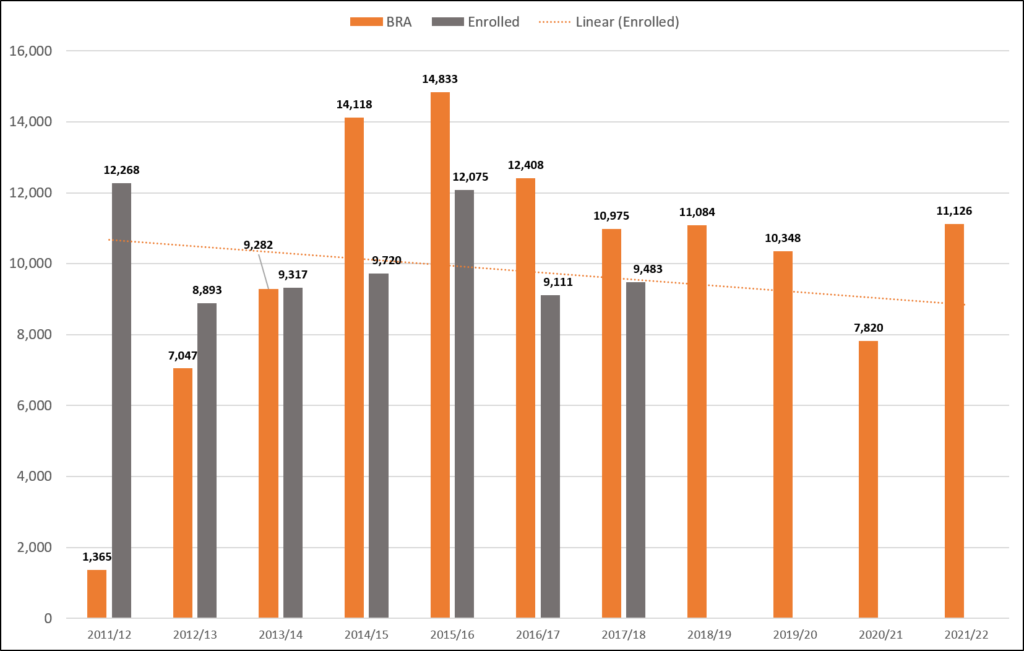
Myth #2: New CP requirements make it difficult to participate in DR.
In my white paper I stated that although grid reliability is PJM’s number one focus (and rightfully so), and the new CP requirements imposed on Demand Response customers appear daunting (with higher noncompliance penalties and much longer requirements to perform), the impact on DR should be negligible. The implementation of CP to help prevent PJM from entering into emergency situations should mean less of a need for emergency resources such as Demand Response.
It appears that Demand Response customers are adjusting their mindsets from thinking that they can—or only want to—participate in summer-only emergency programs, to understanding that they do have the ability to be year-round resources. And Curtailment Services Providers now believe that they can support a Capacity Performance DR offering and feel there are sufficient customers that can comply and meet their RPM Commitments. This is evident in that over 2,000 MW more DR was offered into the 21/22 BRA than the 20/21 BRA. The DR industry is becoming more comfortable with the Capacity Performance program.
Myth #3: 100% CP means PJM is moving away from DR.
The RPM is an auction-based model that PJM uses to meet forward demand, and it does so by clearing sufficient capacity needed for reliability at the cheapest cost to load. PJM recognizes and understands the value that Demand Response resources bring to the market. The 21/22 BRA cleared at much higher prices across the RTO than nearly everyone projected. And although the prevailing thought is that many capacity resources adjusted and increased their offer prices, which caused prices to spike and PJM to clear Demand Response and Energy Efficiency resources in their place, nonetheless the need for these resources has been proven.
Despite what you may have been told, Demand Response is not back, folks. It never really went away. At CPower we expect the market and the programs to continue to change. It’s what we’ve always seen and are always prepared to see. And we will continue to adapt every step of the way while finding new ways to help customers reduce their costs and generate revenues to strengthen their energy management strategies.
Green Buildings Attract Happy Tenants and Bring Green Earnings to the Commercial Real Estate Industry
The following is an excerpt from “Monetizing Energy Assets in the Commercial Real Estate Industry: A Complete Guide for Earning Revenue with demand-side energy management” by CPower:
For the past several years, the economic and policy climate of North America has created an impetus for green and sustainable energy-efficient buildings. The commercial real estate (CRE) industry has contributed to this momentum.
Keeping the supreme goal of providing a great tenant experience at the forefront of their operations, commercial real estate facility managers and executives are increasing their focus on energy management plans rooted in a sustainable building philosophy based on cost-effectiveness and energy-optimization.
The CRE industry’s current push toward a more efficient and sustainable future comes at a serendipitous time when energy markets around the country are working to integrate distributed energy resources (DERs) onto their energy grids in an attempt to diversify their fuel mixes.
Right now and for the foreseeable future, grid operators and electric utilities in each of the nation’s six deregulated energy markets have created a wealth of incentive programs to encourage commercial and industrial organizations to help integrate their grids with distributed energy.
CRE organizations with distributed resources at their facilities like backup generators, solar photovoltaic cells, fuel cells, energy storage and more are therefore in a position to reap significant financial benefits by working with a properly licensed company that can help them monetize their existing energy assets.
The Importance of Tenant Experience
No two commercial buildings are alike and every commercial real estate organization is unique. One trait CRE organization’s share, however, is the unwavering desire to provide a great experience for their tenants.
More and more commercial real estate companies are realizing that sound demand-side energy management–the practice of modifying consumer demand for energy–can play an integral part in providing a great tenant experience.
Without satisfied tenants, of course, the CRE industry wouldn’t exist. That’s why every measure a CRE organization explores concerning energy management should be examined through the tenant-experience lens.
Demand for Green Buildings
Utility costs related to energy, water, and waste have a significant impact on a CRE organization’s profits. For decades, CRE organizations have sought to reduce these impacts by making their buildings more efficient and (if at all possible) environmentally friendly.
Green buildings–those which are environmentally responsible and resource-efficient–are estimated to consume 30-50% less energy than non-green buildings. Green buildings also use an average of 40% less water, emit 30-40% less carbon-dioxide, and produce 70% less solid waste.
Green Buildings, Happy Tenants
In the last several years, CRE organizations across North America have recognized the direct correlation between green buildings and tenant attraction.
The increasing popularity of green leases, which include an up-front establishment of sustainability goals and allocation of implementation responsibilities between the owner and the tenant, is proof that the notion of sustainability is a value shared between CRE organizations and the tenants they serve.
Since the Great Recession, many tenants’ business performance has been and continues to be evaluated by customers and investors looking at aspects beyond the strictly-financial. Tenants want to tell the story of their operating in a green building that actively pursues sustainability efforts with a positive effect on the community and the environment.
CRE organizations who oblige will not only provide a superior tenant experience, they’ll also be in a position to monetize their efforts through demand-side energy management.
Energy Assets in the CRE Industry
CRE Organizations that have made their buildings more energy efficient–whether by lighting upgrades, HVAC improvement, or any other measure, may be eligible to earn money for the permanent reduction of their electric demand.
They may already possess energy assets like back-up generators, energy storage, solar generation, and more that can also earn revenue through demand-side energy management.
Getting started
When selecting a company to guide your demand-side energy management, it’s important to consider the company’s scope of demand-side expertise. Do they serve the markets where your properties reside? Does the company specialize in one type of demand-side energy management, or is it equally skilled in a wide range of energy asset monetization practices?
Most importantly, a demand-side energy management partner should earn your trust in every aspect of the relationship your organizations share.
Demand-side energy management is not a one-size-fits-all exercise. No two buildings are alike and every CRE organization is unique in its complexities.
Like your business, your demand-side energy management strategy should evolve and refine over time, forever in pursuit of perfection as energy markets continue to change and your needs as an organization evolve.
Visit https://cpowerenergy.com/commercial-reit-lp to learn more about CPower’s extensive experience in the commercial real estate industry, including how Tishman Speyer Commercial Real Estate earned more than $1.4 million through demand-side management with CPower as their guide.
To read the entirety of “Monetizing Energy Assets in the Commercial Real Estate Industry: A Complete Guide for Earning Revenue with demand-side energy management” click HERE.
White Paper: Leveraging Your Generation Assets To Generate Revenue
Webinar: Leverage Your Generator Assets To Earn Revenue
Properly permitted, your emergency generation—EG—is both a reliability asset and a revenue generator. EG provides a great opportunity to earn revenue and save on energy costs through demand response (DR) and demand management programs.
The path from emergency generation to revenue generation, though, may seem like a complex, confusing, and occasionally contradictory thicket of state and local environmental regulations. Few organizations fully understand the scope and intricacies of EG regulation, which often results in misinformation, missteps, and missed revenue opportunities.
Fortunately, CPower’s extensive experience and knowledge base has led hundreds of organizations through the jumble of regulations and provided a clear path to monetizing EG assets. This webinar covers everything today’s energy managers and engineers need to to know to maximize the benefits of their EG portfolio. It includes:
- A brief history of emergency generation as a component of demand-side energy management, and the numerous rule changes that have created the current EG landscape
- How existing generators can be upgraded to meet increasingly stringent permitting requirements, bringing previously excluded MWs back into the market
- Success stories illustrating how CPower has helped find and reclaim “lost” megawatts and enroll them in lucrative demand response and demand management programs
Join Ray Berkebile, CPower’s nationally recognized EG permitting expert, and CPower engineer Alison Keefe as they lead this in-depth look at how your EG assets can generate revenue for you, too.
Download the slides: Leverage Your Generator Assets To Earn Revenue Webinar (PDF)







